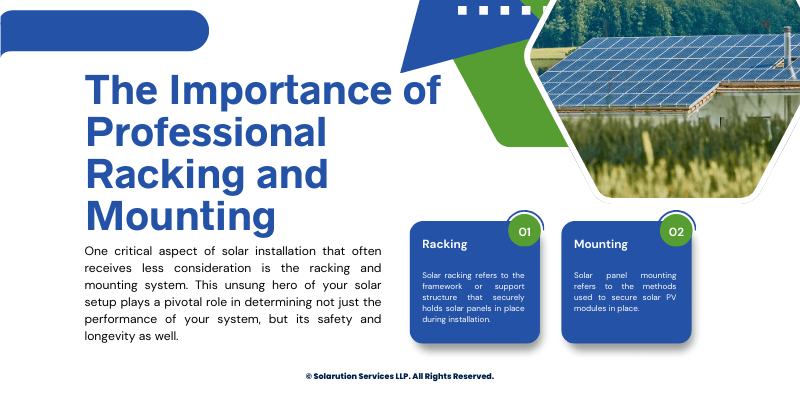When homeowners and businesses decide to invest in solar energy, much attention naturally focuses on the panels themselves—their efficiency, warranty, and power output. However, one critical aspect of solar installation that often receives less consideration is the racking and mounting system. This unsung hero of your solar setup plays a pivotal role in determining not just the performance of your system, but its safety and longevity as well.
The Foundation of Your Solar System:
Solar racking and mounting systems serve as the literal foundation for your entire solar investment. These frameworks support the weight of your panels, secure them against environmental forces, and establish the optimal angle for maximum energy production. While they may not generate electricity themselves, their importance cannot be overstated—a solar array is only as strong as the structure holding it in place.
Protecting Against the Elements:
Solar panels are designed to withstand decades of exposure to the elements, but they can only fulfill this promise when properly secured. Professional racking systems are engineered to withstand:
- High winds that could potentially turn poorly secured panels into dangerous projectiles
- Heavy snow loads that exert significant downward pressure on your roof and panels
- Torrential rain that can find its way into any weaknesses in your roof’s integrity
- Seismic activity that could compromise improperly installed mounting systems
Each geographic region presents its own unique challenges, which is why professionally designed racking solutions take local environmental factors into account. A mounting system appropriate for the snowy Northeast would differ significantly from one designed for hurricane-prone Florida or earthquake-susceptible California.
Preserving Your Roof’s Integrity:
For roof-mounted systems, proper installation is about more than just keeping panels in place—it’s about protecting one of your property’s most vital structures. Amateur or substandard mounting can lead to serious issues including:
- Water infiltration due to improperly sealed roof penetrations
- Structural damage from incorrectly distributed weight loads
- Voided roof warranties resulting from improper installation techniques
- Accelerated roof deterioration from panels mounted too close to roofing materials
Professional installers understand the delicate balance required to secure panels firmly while respecting the structural and material limitations of your roof. They utilize industry-standard flashing, appropriate waterproofing measures, and precise attachment points to ensure your roof remains intact for its expected lifespan.
Optimizing Energy Production:
Beyond safety and structural integrity, professional racking and mounting directly impact your system’s energy production. Proper mounting ensures:
- Optimal tilt angles that maximize solar exposure based on your geographic location
- Appropriate spacing between panels for thermal regulation and maintenance access
- Minimal shading from chimneys, vents, or adjacent panels
- Proper elevation to allow airflow beneath panels, reducing heat build-up that decreases efficiency
Even small deviations in panel orientation can result in substantial energy losses over the system’s lifetime. Professional installers use sophisticated tools to calculate the ideal positioning for maximum energy yield, ensuring you get the best return on your investment.
Compliance with Building Codes and Permitting Requirements:
Solar installations must comply with local building codes, electrical codes, and permitting requirements. Professional racking and mounting systems are designed with these regulations in mind, featuring:
- Engineering stamps certifying structural integrity
- UL-listed components that meet safety standards
- Grounding and bonding provisions that satisfy electrical code requirements
- Documentation necessary for inspection and permit approval
Attempting to cut corners on mounting hardware or installation methodology not only compromises safety but could also result in failed inspections, denied permits, or invalidated insurance coverage.
Long-Term Economics of Professional Installation:
While it might be tempting to view racking as an area to economize, professional mounting systems represent a relatively small percentage of total system cost while providing outsized benefits. Consider that:
- The typical lifespan of quality solar panels exceeds 25 years
- Most solar warranties depend on proper installation and mounting
- Repair costs for damage caused by failed mounting can far exceed the initial savings of cheaper alternatives
- Insurance claims may be denied if systems aren’t installed to code and manufacturer specifications
When amortized over decades of service, the difference between professional and substandard mounting becomes negligible on a monthly basis but enormous in terms of risk mitigation and peace of mind.
Conclusion: An Investment Worth Making:
Your solar energy system represents a significant financial commitment and a long-term relationship with your property. Just as you wouldn’t build a house on a questionable foundation, you shouldn’t mount valuable solar equipment on anything less than professional-grade racking systems installed by qualified technicians.
When evaluating solar proposals, pay particular attention to the specified mounting hardware and installation methodology. Ask questions about wind and snow load ratings, roof warranty preservation, and code compliance. Remember that the visible panels receiving sunlight today will only continue performing reliably tomorrow if they’re secured on a mounting system designed for decades of unwavering support.
By investing in professional racking and mounting at the outset, you’re not just protecting your solar panels—you’re safeguarding your entire solar investment for generations to come.
**********




